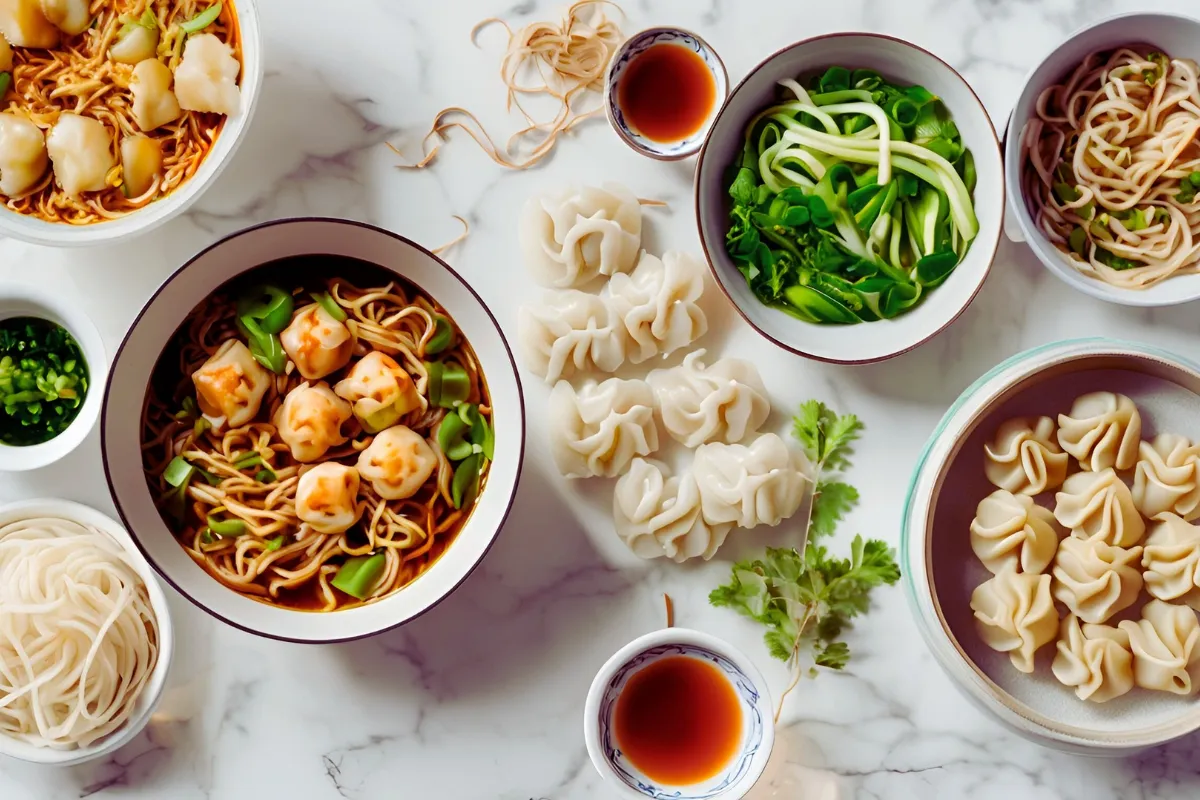Simple Asian Recipes for Delicious Home-Cooked Meals
Cooking at home doesn’t just save you money—it’s a ticket to discovering the world, one plate at a time. Asian cuisine, in particular, offers an incredible mix of flavors, textures, and aromas that’ll keep your taste buds on their toes. From sweet and tangy to spicy and umami-packed, these Simple Asian Recipes bring something special to the table. The best part? Many are simple enough to whip up in your own kitchen without any fancy tricks.
What Makes Asian Recipes Unique?
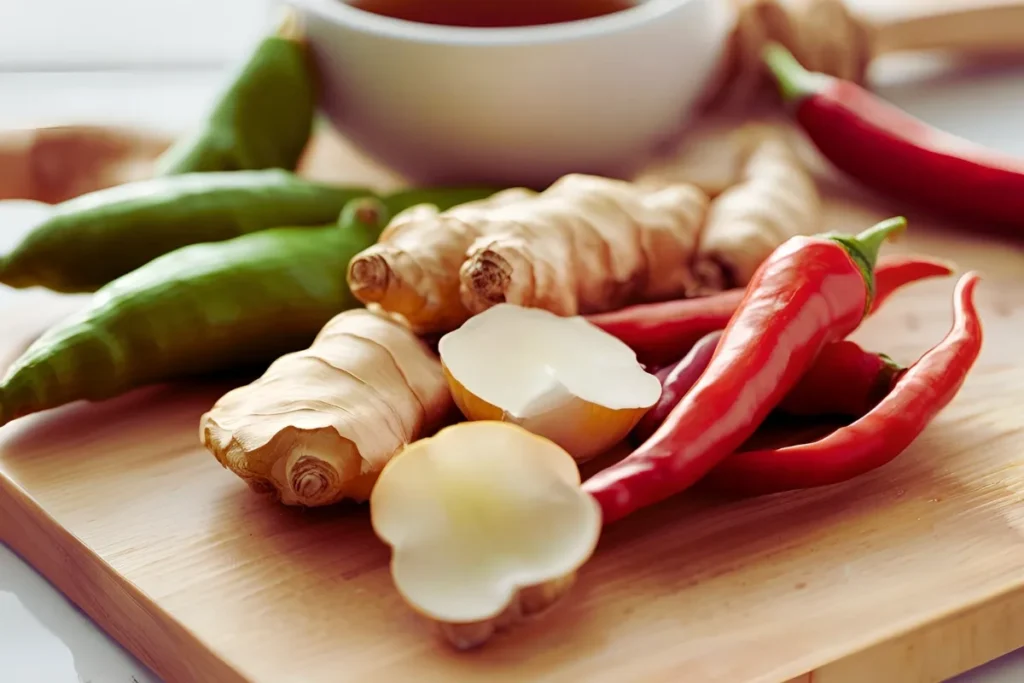
Cultural and Culinary Diversity Across Asia
Asia is a massive continent, and its food reflects that diversity. Whether it’s the soy- and garlic-heavy dishes of East Asia, the fragrant curries of Southeast Asia, or the bold spices of South Asia, every region has its own unique flavor profile. For example, Thailand gives us the perfect balance of sweet, sour, salty, and spicy with dishes like green curry and Pad Thai. Meanwhile, Japan leans into simplicity with sushi and ramen, focusing on fresh ingredients and umami-packed seasonings. And let’s not forget the iconic flavors of China, India, Vietnam, Korea, and beyond.
Common Ingredients That Define Asian Flavors
What ties many of these cuisines together are their base ingredients. Soy sauce, fish sauce, sesame oil, and rice vinegar are pantry must-haves. Fresh herbs like cilantro and basil are equally important, along with spices like turmeric, star anise, and chili. These staples create a foundation that’s easy to build upon, allowing for a world of possibilities.
Why Cook Asian Dishes at Home?
Health Benefits of Homemade Asian Recipes
Let’s face it—takeout is tempting, but cooking at home gives you control over what goes into your food. Many Asian recipes rely on fresh vegetables, lean proteins, and nutrient-rich ingredients like tofu, mushrooms, and seafood. By making these dishes yourself, you can avoid the excessive oils, sodium, and preservatives that sometimes sneak into restaurant meals.
For instance, a homemade stir-fry loaded with bell peppers, broccoli, and carrots delivers a hearty dose of vitamins and minerals. Plus, you can adjust the spice level, sweetness, or saltiness to suit your taste buds and dietary needs.
Affordable Alternatives to Takeout
Cooking Asian food at home isn’t just healthier—it’s also budget-friendly. Instead of shelling out $15 for a single bowl of ramen, you can stock up on noodles, broth, and toppings to make multiple servings for the same price. Basic staples like rice, soy sauce, and frozen dumpling wrappers are inexpensive and versatile, meaning you can create several different meals without breaking the bank.
Who Can Benefit from Learning Simple Asian Recipes?
Busy Families Seeking Quick, Flavorful Meals
For families, weeknight dinners can be a challenge. That’s where Asian recipes come in handy. Stir-frying, for instance, is a super-quick method that locks in flavor without much prep time. Dishes like fried rice or teriyaki chicken can be on the table in under 30 minutes, and they’re crowd-pleasers for both kids and adults.
Food Enthusiasts Exploring New Cuisines
If you’re a foodie looking to expand your horizons, diving into Asian recipes is a no-brainer. From crafting your own sushi rolls to perfecting a pho broth, there’s always something new to learn. And because so many Asian dishes celebrate fresh, high-quality ingredients, they’re perfect for experimenting with seasonal produce or specialty items you find at local markets.
Key Ingredients in Asian Cooking
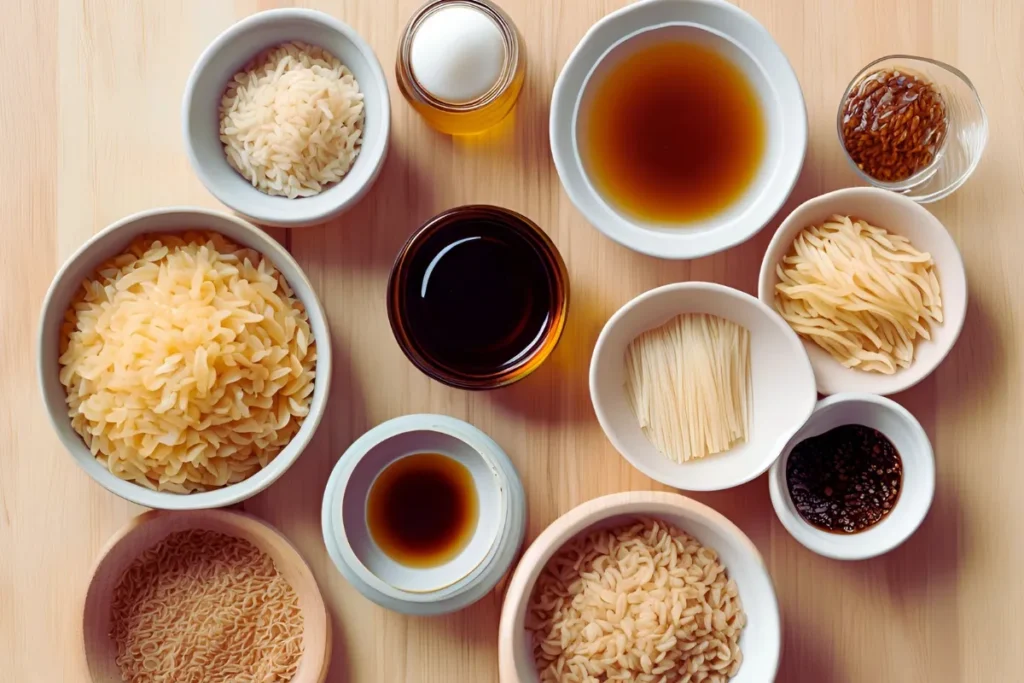
Cooking Asian food begins with understanding its essential ingredients. These staples create the foundation for the diverse flavors that define this cuisine. Having these on hand makes it easy to whip up anything from a quick stir-fry to a hearty bowl of ramen.
Staples Found in Most Asian Pantries
One of the simplest ways to get started with Asian cooking is to stock your pantry with versatile staples. Rice, noodles, and dumpling wrappers are foundational ingredients. Rice, in particular, is a cornerstone of Asian diets, from fluffy jasmine rice in Thai dishes to short-grain rice in Japanese meals. Meanwhile, noodles like rice noodles, udon, and egg noodles open the door to countless recipes, from Pad Thai to lo mein. Dumpling wrappers, whether for wontons or gyoza, can also double as wrappers for creative desserts.
On the seasoning side, soy sauce, fish sauce, and miso paste are non-negotiables. Soy sauce adds a salty, savory punch that works in nearly every Asian dish, while fish sauce lends depth to Southeast Asian recipes. Miso paste, a fermented soybean product, creates rich, umami-packed soups and marinades.
Essential Fresh Ingredients
Fresh ingredients are just as critical as pantry items. For instance, ginger, garlic, and lemongrass are common flavor boosters that add brightness and complexity. Ginger offers a spicy kick, garlic brings warmth, and lemongrass contributes a citrusy aroma that’s a signature of many Southeast Asian dishes.
Vegetables like bok choy and bean sprouts are frequently used and easy to find at most grocery stores. Bok choy works well in stir-fries and soups, while bean sprouts add crunch to noodles, salads, and spring rolls.
Unique Asian Spices and Seasonings
When it comes to spices, Asian cuisine has some truly distinctive options. Five-spice powder blends star anise, cloves, cinnamon, Sichuan pepper, and fennel for a balance of sweet, spicy, and savory flavors. Curry paste is a must-have for creating Thai curries, with red, green, and yellow varieties catering to different flavor preferences. Lastly, Sichuan peppercorns bring a unique numbing sensation to Chinese dishes, setting them apart from anything else you’ve tried.
Techniques for Cooking Asian Dishes
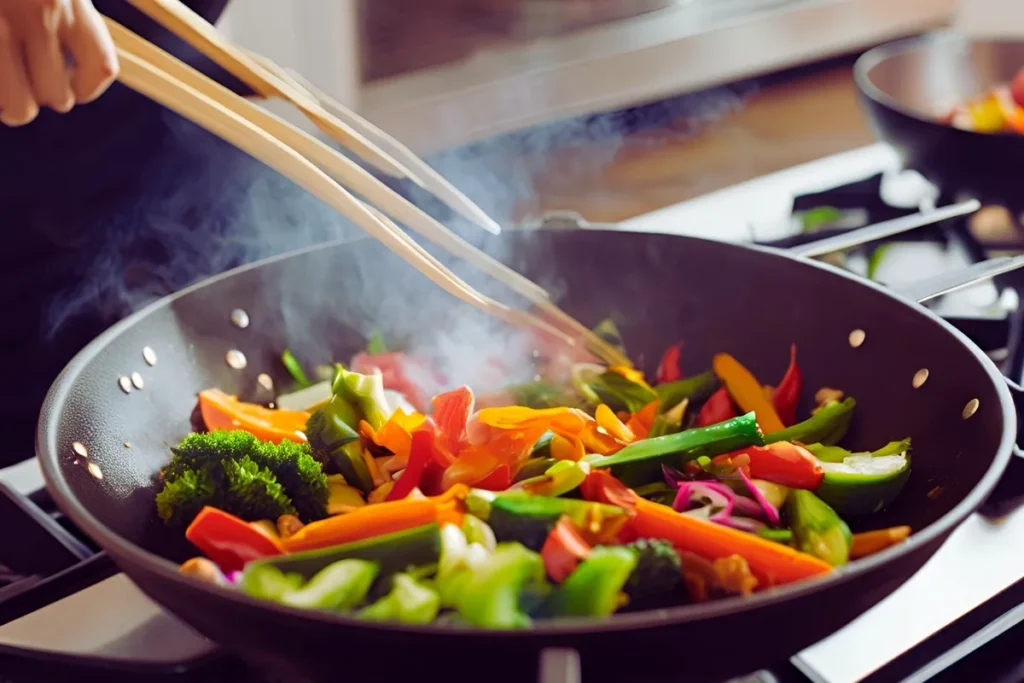
Once your pantry is stocked, the next step is learning the essential techniques that make Asian recipes stand out. These methods aren’t just practical—they’re also designed to maximize flavor and texture.
Stir-Frying for Quick and Flavorful Meals
Stir-frying is the go-to method for many Asian dishes because it’s fast, versatile, and easy. By cooking ingredients over high heat while constantly stirring, you can create meals with bold flavors and vibrant colors in minutes. Dishes like beef and broccoli or chicken chow mein are great examples of how this technique transforms simple ingredients into something special.
Steaming for Healthy and Tender Dishes
For those aiming to keep things light, steaming is a fantastic option. Steamed fish, dumplings, and vegetables retain their nutrients and delicate flavors, making them both healthy and delicious. You don’t need a fancy setup—a bamboo steamer or even a metal rack over boiling water will do the trick.
Mastering Broths for Soups and Ramen
Broths are the heart of many Asian dishes, from Vietnamese pho to Japanese ramen. While they might take a little time, the results are worth the effort. Start by simmering bones, aromatics, and seasonings for a few hours to develop a rich, flavorful base. Once you’ve got a good broth, you can customize it with noodles, proteins, and toppings.
Rolling Sushi and Wrapping Dumplings
If you’re up for a hands-on challenge, sushi and dumplings are fun projects that let you flex your creativity. Rolling sushi requires a bamboo mat and some practice, but it’s incredibly rewarding to make your own rolls at home. Dumpling-making is equally satisfying—fill wrappers with a mix of ground meat and veggies, seal them up, and cook them by steaming, boiling, or pan-frying.
Popular Asian Recipes You Can Make at Home
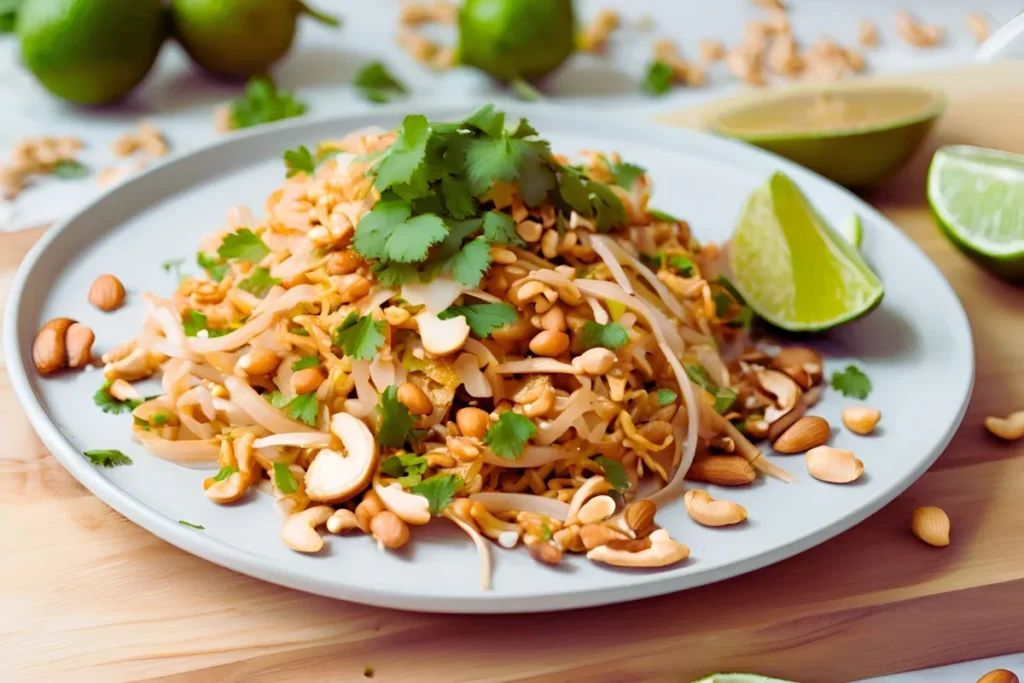
Whether you’re a beginner or a seasoned cook, there’s no shortage of Asian recipes to explore. Let’s look at some classic dishes and simpler options that are perfect for home cooking.
Iconic Dishes Across Asia
Some dishes are so iconic that they’ve become synonymous with the countries they come from. Pad Thai is a quintessential Thai dish, blending tamarind sauce, peanuts, and lime for a tangy, nutty flavor. Pho, the beloved Vietnamese noodle soup, combines fragrant broth, rice noodles, and fresh herbs. And of course, sushi—with its perfect balance of rice, fish, and seaweed—continues to be a global favorite.
Other crowd-pleasers include Chinese fried rice, which is both simple and customizable, and Japanese teriyaki chicken, a dish known for its sweet and savory glaze.
Easy Recipes for Beginners
If you’re new to Asian cooking, don’t worry—there are plenty of recipes that are easy to tackle. Korean bibimbap is a great starting point. This rice bowl topped with sautéed veggies, a fried egg, and spicy gochujang sauce is as delicious as it is colorful. Another beginner-friendly option is Thai green curry, which pairs coconut milk with curry paste for a creamy, aromatic dish that works well with chicken or tofu.
Simple Steps to Master Asian Cooking
Cooking Asian food at home doesn’t have to be overwhelming. With a few key tools, a stocked pantry, and some beginner-friendly recipes, you’ll be well on your way to mastering this cuisine.
How to Set Up Your Kitchen for Asian Recipes
Before diving into recipes, it’s essential to prepare your kitchen for Asian cooking. By organizing your tools and ingredients ahead of time, you’ll streamline the cooking process and reduce any stress.
Tools You’ll Need (Woks, Steamers, and Rice Cookers)
A good wok is arguably the most important tool for Asian cooking. Its high, sloping sides make it perfect for stir-frying, deep-frying, and steaming. If you don’t have a wok, a large skillet can work in a pinch, though it may not produce the same results.
A bamboo or metal steamer is another must-have, especially if you plan to make dumplings, buns, or steamed fish. Rice cookers are optional but incredibly useful, ensuring perfect, fluffy rice every time without the guesswork. They also double as a steamer in some cases, making them a versatile addition to your kitchen.
Stocking Your Pantry with Essential Ingredients
To cook Asian recipes with ease, your pantry should include staples like soy sauce, sesame oil, rice vinegar, and fish sauce. These ingredients form the foundation of many marinades, stir-fry sauces, and soups. Other essentials include dried noodles, rice, and coconut milk, which can be used across a variety of cuisines.
Fresh ingredients should also be prioritized. Keep ginger, garlic, and green onions on hand, as they are frequently used in Asian cooking. Don’t forget fresh herbs like cilantro and Thai basil for garnishing and enhancing flavors.
Quick and Simple Asian Recipes to Try
Sometimes, you need a dish that’s both quick to prepare and satisfying to eat. These beginner-friendly recipes are a great starting point for anyone looking to explore Asian cuisine.
15-Minute Stir-Fried Noodles
This dish is a lifesaver on busy weeknights. Simply toss cooked noodles with a mix of soy sauce, oyster sauce, and sesame oil, then stir-fry with your choice of vegetables and protein. Add a sprinkle of green onions or sesame seeds for extra flavor, and you’ve got a meal that’s ready in no time.
One-Pot Chicken and Rice Congee
Congee, a comforting rice porridge, is perfect for cold days or when you’re feeling under the weather. Simmer rice with chicken, ginger, and water until it reaches a creamy consistency. Garnish with soy sauce, fried shallots, and fresh herbs for a dish that feels like a warm hug.
Easy Vegetarian Spring Rolls
Spring rolls are a fresh and healthy appetizer that’s fun to assemble. Wrap julienned carrots, cucumbers, and lettuce in rice paper, then serve with a tangy peanut or hoisin dipping sauce. They’re customizable, too—add shrimp or tofu for extra protein if desired.
Troubleshooting Common Challenges in Asian Cooking
Even with preparation, you might encounter some challenges when cooking Asian dishes. Fortunately, these issues are easy to fix with a few adjustments.
Adjusting Flavor Profiles (Sweet, Salty, Spicy, Umami)
Balancing flavors is key to successful Asian cooking. If a dish tastes too salty, add a splash of lime juice or rice vinegar to brighten it up. For a dish that’s overly spicy, stir in a bit of coconut milk or sugar to mellow the heat. When you need more umami, a dash of soy sauce or a sprinkle of MSG can make all the difference.
Tips for Perfectly Cooked Rice and Noodles
Rice and noodles are the backbone of many Asian meals, but they can be tricky to perfect. For fluffy rice, rinse it thoroughly before cooking to remove excess starch, and let it rest for a few minutes after cooking. When boiling noodles, make sure to follow the package instructions closely—overcooking can make them mushy, while undercooking leaves them tough.
Looking Ahead: Expanding Your Asian Recipe Repertoire
Once you’ve mastered the basics, there’s a whole world of Asian cuisine waiting to be explored. By experimenting with regional specialties and incorporating seasonal ingredients, you can take your cooking to the next level.
Exploring Regional Specialties Beyond the Basics
Asia is home to countless culinary traditions, each with its own unique flavors and techniques. For instance, Malaysian laksa combines spicy curry paste with creamy coconut milk and rice noodles for a dish that’s both bold and comforting. Filipino adobo, on the other hand, features meat braised in a tangy mix of soy sauce, vinegar, and garlic, creating a dish that’s both savory and slightly sweet.
If you’re a fan of Indian cuisine, butter chicken is a must-try. This dish pairs tender chicken with a rich, tomato-based curry sauce that’s spiced with garam masala and turmeric. And for those who love bold flavors, Indonesian rendang—a slow-cooked beef curry infused with coconut milk and spices—is a guaranteed showstopper.
Final Thoughts on Enjoying Simple Asian Recipes at Home
Cooking Asian food at home is a journey of discovery that’s as rewarding as it is delicious. By starting with simple recipes and gradually expanding your skills, you’ll gain the confidence to tackle even the most complex dishes. Whether you’re preparing a quick stir-fry on a weeknight or hosting a dinner party with homemade sushi, the possibilities are endless.
With the right tools, a well-stocked pantry, and a little creativity, you can bring the flavors of Asia into your kitchen and enjoy restaurant-quality meals without ever leaving home. So grab your wok, pick a recipe, and start cooking—it’s time to transform your kitchen into a culinary adventure!
FAQs
Asian cuisine offers a vast array of flavors, techniques, and dishes that can sometimes leave you wondering where to start. Here are some common questions to help clarify and inspire your culinary journey.
What’s a Popular Asian Dish?
When it comes to popular Asian dishes, sushi, pho, and fried rice are always at the top of the list. Sushi, known for its fresh and delicate flavors, offers endless variety, from classic nigiri to creative rolls. Pho, a Vietnamese noodle soup, features a rich broth, tender beef or chicken, and fresh herbs, making it both comforting and flavorful. Meanwhile, fried rice is a versatile dish that can be customized with your favorite proteins, vegetables, and seasonings.
These dishes are beloved worldwide for their simplicity, adaptability, and delicious taste. Whether you’re dining out or cooking at home, they’re always a hit.
What Are Three Common Foods Used in Most Asian Dishes?
Asian cooking often revolves around a few key ingredients that provide the base for countless recipes. These include:
- Rice: A staple in nearly every Asian country, rice serves as the foundation for dishes like sushi, bibimbap, and curries.
- Soy Sauce: This essential seasoning adds umami and depth to stir-fries, marinades, and dipping sauces.
- Noodles: Whether it’s ramen, udon, or rice noodles, these are used in soups, salads, and stir-fried dishes.
These ingredients are versatile and readily available, making them perfect for anyone starting their Asian cooking journey.
What Asian Foods or Dishes Could Be Made at Home as an Alternative to Takeout?
Homemade versions of popular takeout dishes can be just as satisfying—and healthier! A few great options include:
- Homemade Dumplings and Egg Rolls: These are surprisingly easy to make and can be customized with your choice of fillings, from pork and shrimp to vegetarian options.
- Stir-Fried Vegetables and Ramen Bowls: Quick and adaptable, these dishes let you use whatever fresh ingredients you have on hand.
- Chicken Teriyaki or Beef Bulgogi: These crowd-pleasers are simple to prepare and pair perfectly with steamed rice.
Making these dishes at home allows you to control the ingredients, ensuring a fresher and more nutritious meal.
What Do I Need to Cook Asian Food?
Cooking Asian food doesn’t require a professional setup, but a few tools and ingredients are essential:
- Basic Tools and Equipment: A wok is invaluable for stir-frying, while a bamboo steamer is great for dumplings and buns. Rice cookers ensure perfectly cooked rice every time.
- Starter Pantry Items: Soy sauce, sesame oil, fish sauce, rice vinegar, and miso paste are must-haves. Dried noodles and rice are also staples for most dishes.
Where to Source Asian Ingredients Locally or Online
Asian grocery stores are the best places to find specialty items like lemongrass, curry paste, and dumpling wrappers. If you don’t have one nearby, many online retailers offer a wide selection of Asian ingredients that can be delivered straight to your door.
How Can I Make Asian Dishes Authentic?
To achieve authentic flavors, start with traditional ingredients and follow recipes closely. Using items like Sichuan peppercorns, Thai basil, and fermented sauces can elevate your dishes and give them that restaurant-quality taste. Additionally, take time to learn techniques like stir-frying, steaming, and rolling sushi, as these methods are integral to Asian cooking.
Cooking Asian food at home is both fun and rewarding. With a bit of practice, you’ll soon be impressing friends and family with your culinary skills. So dive in, experiment, and enjoy the journey!

